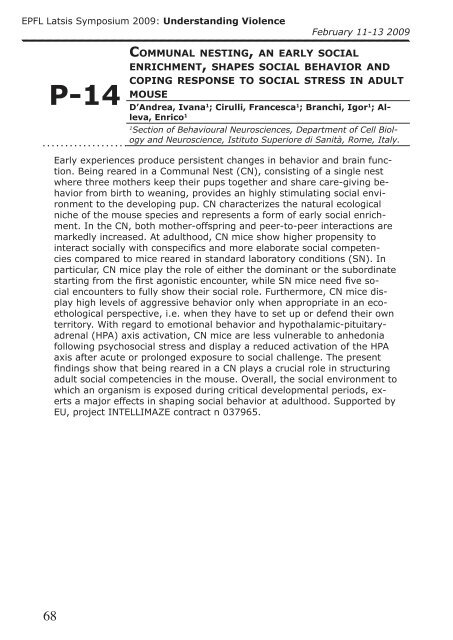Program & Abstract Book - EPFL Latsis Symposium 2009
Program & Abstract Book - EPFL Latsis Symposium 2009
Program & Abstract Book - EPFL Latsis Symposium 2009
Create successful ePaper yourself
Turn your PDF publications into a flip-book with our unique Google optimized e-Paper software.
<strong>EPFL</strong> <strong>Latsis</strong> <strong>Symposium</strong> <strong>2009</strong>: Understanding Violence<br />
P-14<br />
68<br />
February 11-13 <strong>2009</strong><br />
co m m u n a l n e s t i n g , a n e a r l y s o c i a l<br />
e n r i c h m e n t , s h a p e s s o c i a l b e h a v i o r a n D<br />
c o p i n g r e s p o n s e t o s o c i a l s t r e s s in a D u l t<br />
m o u s e<br />
D’Andrea, Ivana 1 ; Cirulli, Francesca 1 ; Branchi, Igor 1 ; Alleva,<br />
Enrico 1<br />
1 Section of Behavioural Neurosciences, Department of Cell Biology<br />
and Neuroscience, Istituto Superiore di Sanità, Rome, Italy.<br />
Early experiences produce persistent changes in behavior and brain function.<br />
Being reared in a Communal Nest (CN), consisting of a single nest<br />
where three mothers keep their pups together and share care-giving behavior<br />
from birth to weaning, provides an highly stimulating social environment<br />
to the developing pup. CN characterizes the natural ecological<br />
niche of the mouse species and represents a form of early social enrichment.<br />
In the CN, both mother-offspring and peer-to-peer interactions are<br />
markedly increased. At adulthood, CN mice show higher propensity to<br />
interact socially with conspecifics and more elaborate social competencies<br />
compared to mice reared in standard laboratory conditions (SN). In<br />
particular, CN mice play the role of either the dominant or the subordinate<br />
starting from the first agonistic encounter, while SN mice need five social<br />
encounters to fully show their social role. Furthermore, CN mice display<br />
high levels of aggressive behavior only when appropriate in an ecoethological<br />
perspective, i.e. when they have to set up or defend their own<br />
territory. With regard to emotional behavior and hypothalamic-pituitaryadrenal<br />
(HPA) axis activation, CN mice are less vulnerable to anhedonia<br />
following psychosocial stress and display a reduced activation of the HPA<br />
axis after acute or prolonged exposure to social challenge. The present<br />
findings show that being reared in a CN plays a crucial role in structuring<br />
adult social competencies in the mouse. Overall, the social environment to<br />
which an organism is exposed during critical developmental periods, exerts<br />
a major effects in shaping social behavior at adulthood. Supported by<br />
EU, project INTELLIMAZE contract n 037965.


